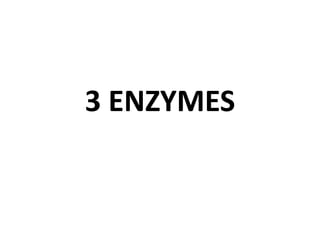
3 Enzymes
- 1. 3 ENZYMES
- 2. LO • explain that enzymes are globular proteins that catalyse metabolic reactions; • explain the mode of action of enzymes in terms of an active site, enzyme-substrate complex, lowering of activation energy and enzyme specificity
- 3. ENZYMES • Protein molecules; globular proteins • Biological catalysts – speed up chemical reactions but remains unchanged at the end of the reaction • Name ends with –ase • Coiled into precise three dimensional shape with hydrophilic groups on the outside of the molecule = soluble
- 4. Active site • Region to which another molecules (substrate) can bind • Lock and key hypothesis – Substrate is the key whose shape fits the lock of the enzyme – The substrate is held in place by temporary bonds which form between the substrate and some of the R groups of the enzyme’s amino acids = enzyme-substrate complex
- 6. • Induced fit hypothesis – Same as lock and key but adds the idea that: – Substrate and enzyme can change shape slightly as the substrate molecule enters the enzyme in order to ensure a perfect fit = more efficient catalysis
- 7. 3
- 8. • Each type of enzyme will act on only one type of substrate molecule = enzymes are specific • Enzymes can catalyse the joining of two substrates (synthesis) or braking down the substrate (lysis) = products • Enzyme remains unchanged • Rate can be very high
- 10. • Lyzozyme – Enzyme in saliva, tears and other secretions – Natural defence against bacteria – Breaks the polysaccharide chains that form the cell walls of bacteria
- 11. Activation energy • Extra energy given to the substrate so that the reaction can happen • Energy of the reactant can be increased by heating (benedict’s test) • Enzymes decrease the activation energy to the reaction
- 13. Factors effecting the enzyme activity • The effect of enzyme concentration – The more enzyme present, the more active sites will be available for the substrate to slot into – As long as there is plenty of substrate available, the initial rate of a reaction increases linearly with enzyme concentration – P. 59. fig. 3.6
- 14. • The effect of substrate concentration – As substrate concentration increases, the initial rate of reaction also increases – The more molecules are around the more often an enzyme’s active site can bind with one – If the enzyme reaches its maximum possible rate = Vmax (maximum velocity)
- 15. • The effect of temperature – Low temperatures – reaction takes place very slowly as the molecules move relatively slowly – As temperature increases – molecules move faster and therefore collide with the active site of an enzyme more frequently; more energy is involved = easier for bonds to be formed or broken – At some point – bonds within the enzyme break and enzyme looses its shape and activity = it is DENATURATED
- 16. – Optimum temperature = temperature at which an enzyme catalyses a reaction at the maximum rate (mostly 40 degrees)
- 17. • The effect of pH – Most enzymes work fastest at a pH of around 7; some work better in acidic conditions (pepsin) – Too different pH can cause denaturation – The lower the pH the higher the hydrogen ion concentration – hydrogen ions can interact with the R-groups of amino acids – this affects the ionic bonding between the groups which affects the 3D arrangement of the enzyme
- 18. Enzyme inhibitors • If a different molecule (very similar in shape to the enzyme’s substrate) binds with the active site of an enzyme – this inhibits the enzyme’s function = this molecule is called INHIBITOR
- 19. • Competitive inhibition – If an inhibitor molecule binds only briefly to the site = competition between it an the substrate for the site – If there is much more substrate than the inhibitor – substrate molecules can easily bind to the active site in the usual way = no effect on the enzyme’s function – If the concentration of inhibitor is rises = less likely that the substrate will collide with an empty site – This process is reversible
- 20. – Example: – ethylene glycol – used as antifreeze; if drunk by somebody, it is rapidly converted to oxalic acid which causes irreversible kidney damage – The active site of the enzyme will accept ethanol – If the person is given ethanol – it acts as a competitive inhibitor = results in slowing down the reaction for long enough to allow the ethylene glycol to be excreted
- 21. • Non-competitive inhibition – Inhibitor can remain permanently bonded with the active site and therefore cause an irreversible block to the substrate – No competition occurs – Example: – Penicillin – permanently occupies the active site of an enzyme that is essential for the synthesis of bacterial cell wall
- 22. • Second type of non-competitive inhibition – Molecule binds to another part of the enzyme (not the active site) – this disrupts the normal arrangement of hydrogen bonds and hydrophobic interactions holding the enzyme molecule in its 3D shape = results in unsuitability of the enzyme for the substrate; the enzyme is blocked – This inhibition can be reversible
- 23. – Example: – Digitalis – binds with ATPase = increase in the contraction of heart muscle Inhibition of enzyme function can be lethal, but in many situations inhibition is essential!
- 25. • End product inhibition – Using end product of a chain of reactions as an enzyme inhibitor – As the enzyme converts substrate to product, it is slowed down because the end-product binds to another part of the enzyme and prevents more substrate binding – As product levels fall, the enzyme is able to top them up again – non-competitive reversible inhibition